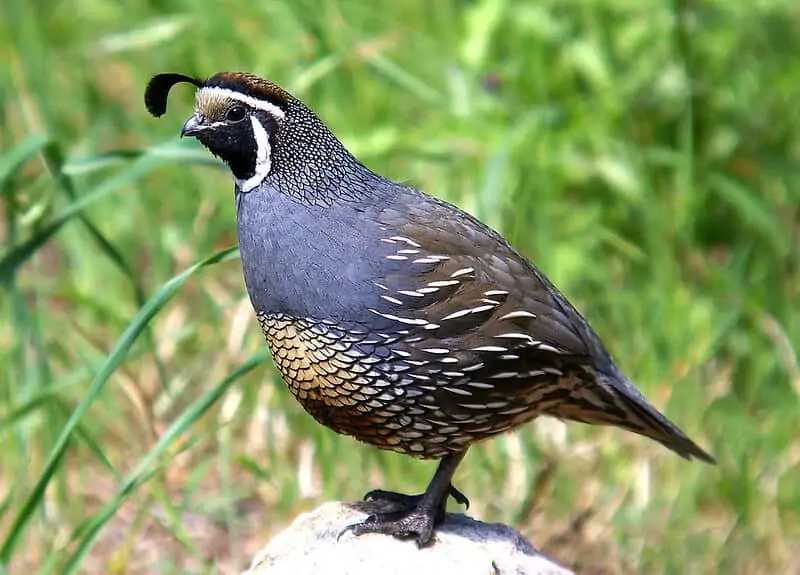Many wild bird species may be found in Utah, which includes the Great Salt Lake. Some of the species are migratory, while others may be found in Utah throughout the year. We’ll explore 24 of Utah’s most frequent backyard birds and learn a little about each one in this article.
I’ll teach you how to attract them to your yard and give you a crash course in the 10 different types of bird feeders available after that. Finally, I’ll provide information on some of Utah’s greatest local birding groups and a few birdwatching hotspots.
How many different species of wild birds are in Utah?
It’s tough to provide a precise estimate of the number of bird species that may be discovered in North America, the United States, or Utah. Nonetheless, as of 2021, the Utah Bird Records Committee claims that at least 467 species of birds are officially recognized on the state’s list.
We’re going to examine just a few of the species that people commonly see in Utah, especially in their backyards, for the purposes of this article.
24 COMMON BACKYARD BIRDS IN UTAH
We’ll take a look at 24 different Utah backyard birds, including some migrants, below. These are some of the birds that are most likely to frequent backyards in Utah, but they aren’t all of the species in the state, or even close to it. Let’s get started right away!
1. WOODHOUSE’S SCRUB-JAY

Scientific name: Aphelocoma woodhouseii
Length: 11.0-11.8 in
Weight: 2.5-3.5 oz
The large birds have a long, slender build and are bigger than a robin. With a gray back, they have blue heads, wings, and tail. The throat is covered with shaggy white feathers, while the chest and belly are light gray. Pinon-juniper and oak-pinyon woodland is where they prefer to live. These scrub jays may be found in golf courses, parks, and suburbs and are fairly comfortable around humans.
Every year, Utah’s scrub jay can be found around woodhouses.
Sunflower seeds, peanuts, and other nuts are all available in the yard for Woodhouse’s scrub jay. Because their diet changes to include more insects in the summer, they may visit more often during the winter.
2. WHITE-CROWNED SPARROW

Scientific name: Zonotrichia leucophrys
Length: 5.9-6.3 in
Weight: 0.9-1.0 oz
Wingspan: 8.3-9.4 in
During the summer, white-crowned sparrows live in Canada and Alaska, then move back over the United States during the winter. White-crowned sparrows have a strong black and white striped head, but the remainder of their face, chest, and belly are a plain buffy brown-gray. They are one of the easiest sparrows to identify. Fields are a favorite hunting spot for them, as are road and trail edges. Sparrows will visit bird feeders, but will mostly stay on the ground and collect spilled seed rather than fly.
These sparrows may be seen year round in most of Utah, but only in the fall and winter along the western and southern borders.
Feeders attract white-crowned sparrows, who like to collect fallen seed beneath them. Sunflower, millet, and blended seed blends are all available.
3. RED-WINGED BLACKBIRD
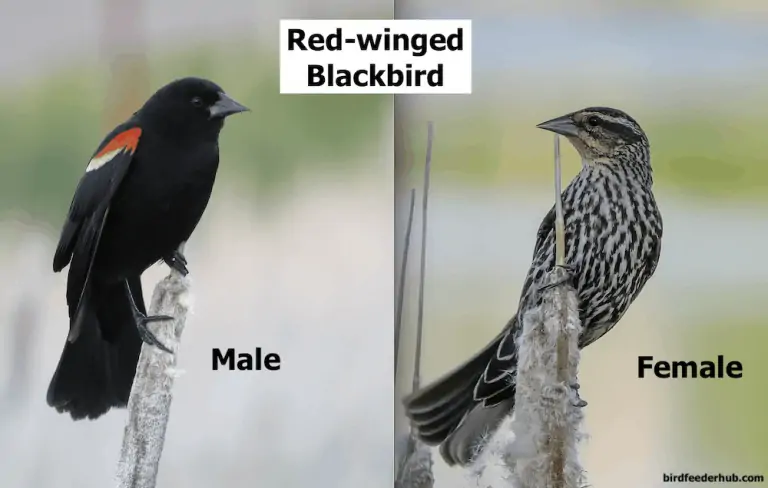
Scientific name: Agelaius phoeniceus
Length: 6.7-9.1 in
Weight: 1.1-2.7 oz
Wingspan: 12.2-15.8 in
Male red-winged blackbirds are one of the most common birds in North America, with their crimson and yellow “shoulders” standing out against their dark plumage. Nonetheless, the females of this species are mostly brown with light streaks, and they look very different. Males will have up to 15 different females that they are mating with, making them a polygynous species. Unfortunately, they can be found in flocks at feeders, eating seed quickly.
Utah is home to red-winged blackbirds all year.
Most kinds of feeders are visited by red-winged blackbirds, who will eat both seed and suet.
4. AMERICAN ROBIN

Scientific name: Turdus migratorius
Length: 7.9-11.0 in
Weight: 2.7-3.0 oz
Wingspan: 12.2-15.8 in
Robins are a common sight in backyards, where they hop around the grass, hunting for worms and other invertebrates. They do not eat seeds, and they seldom feed at bird feeders. They’re easy to identify because of their bright orange round bellies, yellow beaks, and increased size. From dawn until dusk, they are regular performers.
Throughout Utah, Robins are found year-round.
Attract American Robins to seed feeders with meal worms, native fruit-bearing plants, or a bird bath. They don’t visit them often.
5. MOURNING DOVE
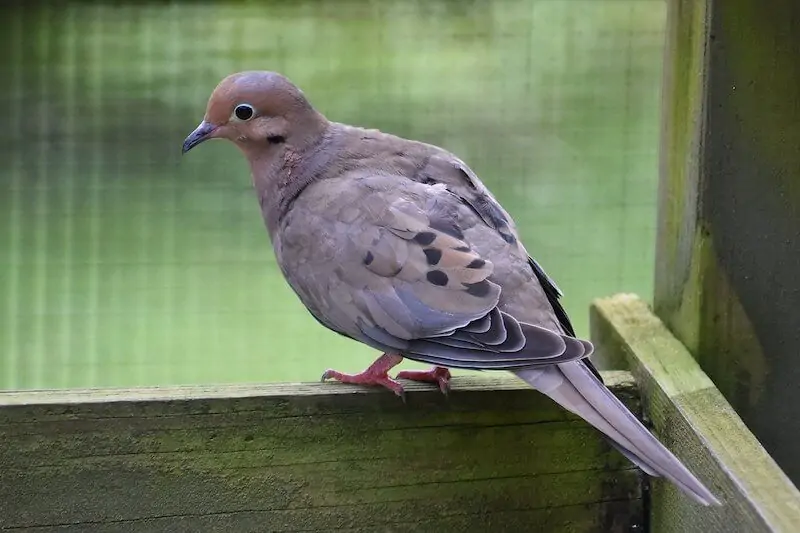
Scientific name: Zenaida macroura
Length: 9.1-13.4 in
Weight: 3.0-6.0 oz
Wingspan: 17.7 in
Doves are typically seen sitting perched on telephone wires or in clusters in trees, and are about the size of a Robin. They’re frequently seen ambling around on the ground beneath hanging bird feeders, but they’re more often seen on my tray feeder. Gray mourning doves have black marks on the top and a pale peachy color below, with pink legs. Males and femen look the same.
Throughout Utah, Mourning Doves are seen throughout the year.
Seed feeders are often visited by doves, although they prefer to scour the ground for fallen seeds. Sprinkle some seeds on the ground or try a ground feeder with a mixed seed blend.
6. EUROPEAN STARLING

Scientific name: Sturnus vulgaris
Length: 7.9-9.1 in
Weight: 2.1-3.4 oz
Wingspan: 12.2-15.8 in
In the 1890s, 100 starlings were released in New York and have since spread across the United States. They destroy other birds’ nests, murdering their chicks, and they’ll come upon feeders and steal the food that you provide. They feature yellow beaks and feet and are mostly dark with white specks on their backs and wings. In the right light, starlings may appear to be quite lovely, with a purple and green iridescent color.
Every state in the lower 48 has starlings, including Utah, which is located year-round.
Almost anything can be eaten by European Starlings. We recommend that you do not try to attract them, since they are an invasive species and will show up anyway.
7. HOUSE FINCH

Scientific name: Haemorhous mexicanus
Length: 5.1-5.5 in
Weight: 0.6-0.9 oz
Wingspan: 7.9-9.8 in
Within their range, the House Finch is a fairly common backyard bird. They didn’t expand across the eastern United States, despite being west-coast natives. They were trying to sell caged finches until the 1940s, when they were released. They may appear in small flocks and mob your feeders if you attract them, which is rather easy to do. Brown with extensive white streaking on both sexes. On the head, chest, and back of males, red splashes appear.
Throughout the year, Utah’s house finches can be found everywhere.
Black sunflower or mixed seed is preferred by House Finches, who enjoy bird feeders. House Finches, like other finches, will go to thistle feeders as well.
8. HOUSE SPARROW

Scientific name: Passer domesticus
Length: 5.9-6.7 in
Weight: 0.9-1.1 oz
Wingspan: 7.5-9.8 in
House sparrows are the sole other kind of wild bird in the United States, and they are often seen as pests. Apart from starlings, which you may legally capture and kill humanely. They, too, were brought to New York in the 1800s and have spread across the United States like wildfire as an invasive species. Their wings and buffy chest are streaked with black and brown, and they are mostly brown in color. With a black mask and chest, males are frequently noticeable. They are generally hostile to other birds, especially those around nests and birdhouses.
Throughout Utah, house sparrows may be found throughout the year.
House Sparrows, like European Starlings, are invasive and endanger native species. The majority of seeds will be consumed.
9. YELLOW-RUMPED WARBLER

Scientific name: Setophaga coronata
Length: 4.7-5.5 in
Weight: 0.4-0.5 oz
Wingspan: 7.5-9.1 in
Depending on its location, the Yellow-rumped warbler’s color pattern may change. The Audubon’s variety, which has a vivid yellow throat, rump, and sides in Utah, is the most common one to see. On top of their head, you may even see a little yellow. The color pattern of females is the same, however the colors are duller and the patterns are less distinct than those of males. Their colors will be at their most vivid and brilliant in the spring, then steadily fade throughout the winter, as they do with other warblers.
Depending on where you live in the state, when and where to see this bird might change. Yellow-rumped warblers are most often seen in Utah during the spring and fall migrations, however.
Bird feeders are sometimes visited by yellow-rumped warblers. Sunflower seeds, suet, and raisins are all good attracts for them.
10. LESSER GOLDFINCH

Scientific name: Spinus psaltria
Length: 3.5-4.3 in
Weight: 0.3-0.4 oz
Wingspan: 5.9-7.9 in
As illustrated above, the male lesser goldfinch has a black head, yellow belly, and white wing patches. They might also be seen as a dark glossy black all over their head and back, which is another plumage variation. The underside of females is yellow, and their head and back are olive-colored. These finches are frequently found in a flock with other goldfinches, house finches, and sparrows.
Throughout the spring and summer breeding season, the lesser goldfinch may be found primarily in Utah, however they may stay all year in certain areas of the state.
Sunflower seeds and nyjer (thistle) seed are favorites of lesser goldfinches, who will flock to feeders.
11. RUBY-CROWNED KINGLET

Scientific name: Regulus calendula
Length: 3.5-4.3 in
Weight: 0.2-0.3 oz
Wingspan: 6.3-7.1 in
The white wing bars, yellow edge wing feathers, and white eye ring distinguish this little kinglet from other species. When excited, the male will flash a little area of intense red feathers on top of his head, but they are normally covered. They’re darting through shrubs and trees, flicking their wings, and they’re high-energy foragers. Wing-flicking is a common way to identify oneself. They may lay up to 12 eggs at a time, even for such a little bird.
The Ruby-crowned kinglet is found in most of Utah throughout the year, but during the winter, they may be seen more frequently in certain areas.
Bird feeders are available for Ruby-crowned kinglets. Sunflower chips, suet, peanut pieces, and mealworms are some of the ways you can attract them.
12. SPOTTED TOWHEE
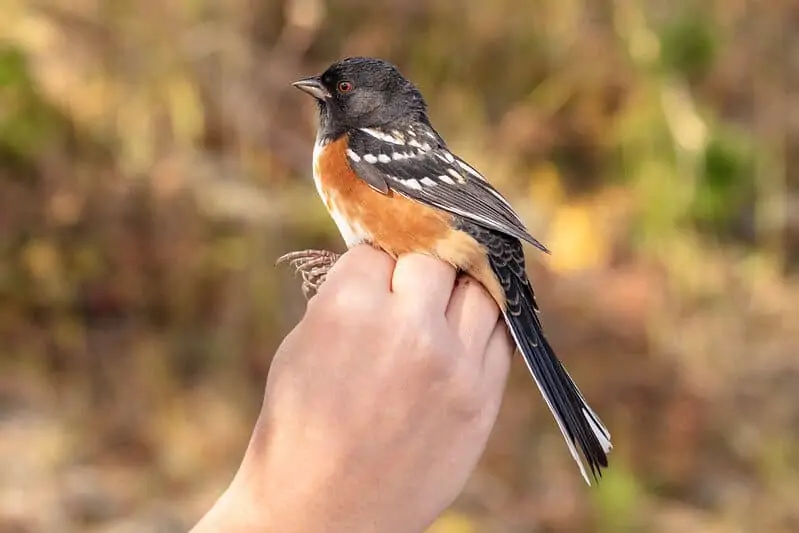
Scientific name: Pipilo maculatus
Length: 6.7-8.3 in
Weight: 1.2-1.7 oz
Wingspan: 11.0 in
The spotted towhee is a fun little backyard bird that’s always a treat to watch. The head, back, wings, and tail of both sexes are black, with white wing markings, rusty sides, and a white belly. Males, on the other hand, have a black complexion, whereas females have a brown complexion. Towhees look for insects, seeds, and berries among the leaves and grass of master foragers. It’s entertaining to observe them scratching at the ground with their doubled-footed backwards hopping motion. Leave some brushy edges and leaf litter along your yard line to increase the likelihood of attracting towhees to your yard.
Throughout most of Utah, spotted towhees may be seen all year, but in the state’s northeastern reaches, they are only present during the summer.
Spotted towhees do not often eat from bird feeders, although they will seek seed on the ground beneath them if given the opportunity. Keep some brushy vegetation in the yard that may attract them, or scatter mixed seed on the ground.
13. NORTHERN FLICKER

Scientific name: Colaptes auratus
Length: 11.0-12.2 in
Weight: 3.9-5.6 oz
Wingspan: 16.5-20.1 in
In backyards across the United States, these medium to huge woodpeckers may be found. They’re also one of the most gorgeous birds in North America, in my opinion. Flickers prefer to locate insects on the ground rather than in the trees, unlike other woodpeckers. The black patches on their bellies, thick black bib, buffy brown complexion, and striped black and gray wings will help you identify them. Males have a crimson “mustache,” whereas ladies do not. The red-shafted variety is found in Utah, and their wings and tail have brilliant crimson feathers on the underside.
In Utah, northern flickers may be found all year.
Although Northern Flickers do not visit suet feeders as often as other woodpecker species, they will come to them. You may observe them digging around for insects if you have some leaf mounds in your yard.
14. DARK-EYED JUNCO
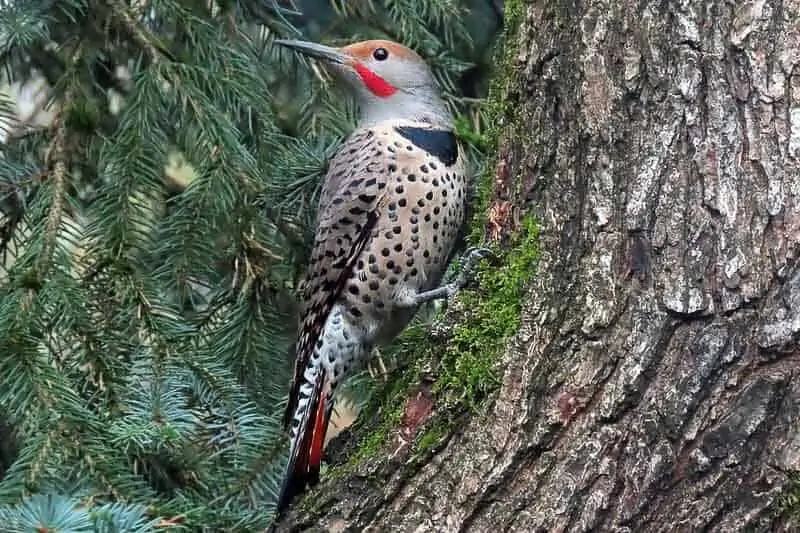
Scientific name: Junco hyemalis
Length: 5.5-6.3 in
Weight: 0.6-1.1 oz
Wingspan: 7.1-9.8 in
Since they spend their summers up in Canada, Juncos are often considered as winter birds in the United States. Throughout the United States, there are many sub-species. have slight color variations. The “Oregon,” as well as the other variants with a pink side, are prevalent in Utah, but the slate-colored or gray-headed varieties may also be seen. You can tell birds apart using a field guide from your area.
The pale pink beak and roundish body shape of dark-eyed junco are two good characteristics to look for when identifying them on all types. The head and back are generally darker, while the belly is generally lighter. They’re most often seen hopping around on the ground in woods and wooded regions.
During the winter, juncos may be more numerous in Utah, and during these non-breeding months, you may get a variety of juncos. Yet, juncos may stay year-round in Utah, one of the states where they are found.
Juncos will visit feeders on occasion, however they prefer to eat seed from the ground beneath your feeders, rather than dropping it. They prefer a combination of different seeds.
15. BLACK-CAPPED CHICKADEE

Scientific name: Poecile atricapillus
Length: 4.7-5.9 in
Weight: 0.3-0.5 oz
Wingspan: 6.3-8.3 in
Because of their black cap and black bib, chickadees are small little birds with rounded bodies that are very easy to identify. Their underbodies are fluffy and light, with white cheeks and blackish gray wings and backs.
They’re frequently seen darting back and forth from a feeder to cover and then return for more, which is typical at bird feeders. Chickadees are small enough to be incredibly bold for their size and are typically among the first birds I notice visiting a new feeder in my yard.
Throughout the year, black-capped chickadees may be found in Utah.
Most seed feeders will be visited by Chickadees, who will provide mixed seed blends and black sunflower seeds.
16. CALIFORNIA QUAIL
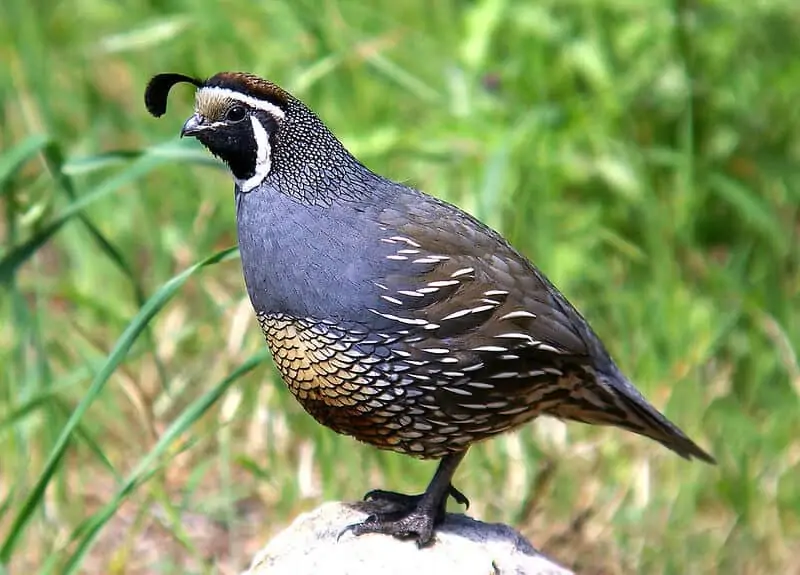
Scientific name: Callipepla californica
Length: 9.4 – 10.6 in
Weight: 4.9 – 8.1 oz
Wingspan: 12.6 – 14.6 in
The little California quail has a brownish back with white streaks, a speckled neck, and a plume that protrudes from the top of their skull. It has a gray neck and body. The head crest of females is small, and they are less colorful overall. Males have a chestnut patch on their belly, bold black and white patterns on their face, and a huge black feather in the shape of a comma atop their skull. The white specks on the neck and scaling on the belly of the California quail differentiate them from Gambel’s quail, which is another Utah resident.
Throughout the year, California quails stay in Utah. They scratch through the scanty, low vegetation looking for seeds and other foods. The most sightings seem to occur near the Great Salt Lake and Salt Lake City, although they can be found throughout the state.
If you have scattered seed around the yard, such as corn, millet, milo, and sunflower, California quails will come to examine it. If they have some shrubby cover to retreat to if spooked, they’ll be more comfortable near your house.
17. CASSIN’S FINCH

Scientific name: Haemorhous cassinii
Length: 6.3 in
Weight: 0.8 – 1.2 oz
Wingspan: 9.8 – 10.6 in
A stocky-looking finch named Cassin. Males have a rosy, pinkish-red wash over their face, breast, and upper back. They have a white belly with a brown back. A darker rosy red color sits atop their head. Females are completely devoid of red coloring. They have a white breast and extensive streaking over their bodies.
They do resemble the house finch, which is also on this list, and you would be correct. Cassin’s males have a deeper, more obvious crimson crown, a crimson back, and no streaking on their belly. The Cassin’s female will have crisper streaking on the belly, but females are even more difficult to distinguish.
Mountain woods with evergreen trees are preferred by the cassin’ finch. Utah is home to them all year long.
During the winter, Cassin’s finches will come to visit your backyard feeders. Mixed and sunflower seeds are their favorites. Fruiting shrubs like mulberry, grape, and firethorn may also be used to attract them to your yard.
18. DOWNY WOODPECKER

Scientific name: Picoides pubescens
Length: 5.5-6.7 in
Weight: 0.7-1.0 oz
Wingspan: 9.8-11.8 in
The common backyard birds, the Downy, are fond of visiting bird feeders. They’re one of the first species I notice at a new bird feeder because they’re the tiniest woodpeckers in North America. Their white underbodies, black wings with white dots, black and white striped heads, and crimson patch on the rear of their heads (males have no crimson) distinguish them immediately. Downy’s are smaller than Hairy Woodpeckers, although they look a lot like them.
Throughout Utah, the downy woodpecker can be found year-round.
With most kinds of bird feeders, Downy Woodpeckers are plentiful. Mixed seed, black sunflower seed, and suet should be offered.
19. EURASIAN COLLARED-DOVE

Scientific name: Streptopelia decaocto
Length: 11.4-11.8 in
Weight: 4.9-6.3 oz
Wingspan: 13.8 in
The Eurasian collared dove is a European and Asian native, as its name suggests. Several of them arrived in Florida in the 1970s after escaping a Bahamian dog store. These dispersed birds, as well as some released in the south Caribbean on Guadeloupe, are thought to have started the colonization of the United States. They may now be found throughout most of the United States. Mexico and the United States are also included. With a chunkier body and a longer tail, they resemble mourning doves. mourning doves have black dots on their backs, whereas these don’t; instead, they have a plain back with a black stripe over their neck.
Year-round, you may see the Eurasian collared dove in Utah.
Doves in Eurasia will visit backyards to feed on seeds and grain from platform feeders or strewn about the area. Millet is especially popular among them.
20. AMERICAN GOLDFINCH
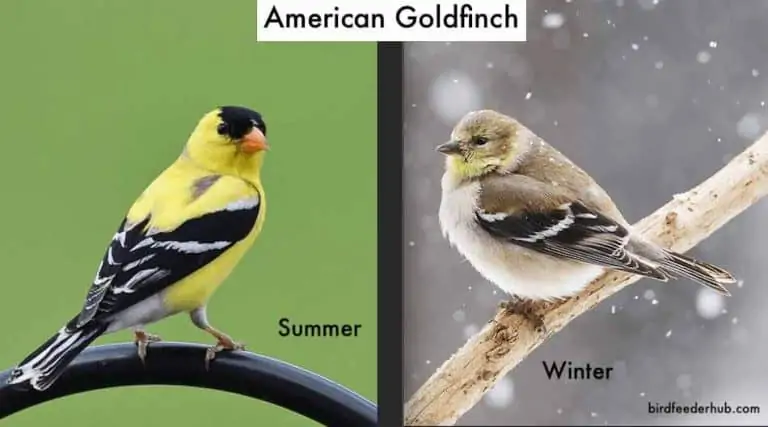
Scientific name: Spinus tristis
Length: 4.3-5.1 in
Weight: 0.4-0.7 oz
Wingspan: 7.5-8.7 in
When the bright yellow feathers of American goldfinches are in the spring and summer, they are among my favorite birds to see at feeders. Males have a black cap on top of their heads during this time, and they are mostly yellow, or “gold,” with black-tipped wings. Their bright yellow turns a more drab brownish or olive color during the winter, and they molt. The black on their wings and beaks, as well as the finch-like shape of their beaks, are always identifiable.
The northern part of Utah is home to the American goldfinch all year, but during the winter months, they are only seen in the southern part of the state.
Thistle feeders are preferred by goldfinches, and they’ll eat sunflower chips if they’re available. But a thistle feeder is the best way to attract them.
21. BLACK-BILLED MAGPIE

Scientific name: Pica hudsonia
Length: 17.7-23.6 in
Weight: 5.1-7.4 oz
Wingspan: 22.1-24.0 in
The black-billed magpie is a jay with the look of a crow and the size of a magpie. Metallic blue along their wings and a long tail, with black head, chest, and back. Fruit, grain, insects, small mammals, carrion, and eggs are among the foods they consume. They’re also spotted scouring the hair of big animals like moose and deer for ticks, hanging out on the backs of them. These bright birds are often seen perched on trees or on fenceposts, and they aren’t afraid. Particularly in groups, they can be quite boisterous.
In Utah, black-billed magpies can be found year-round.
Black-billed magpies may visit backyards, although they prefer open rangeland. On a platform feeder, using suet or leaving out fruit like orange halves, try to attract them with sunflower seeds and peanuts.
22. PINE SISKIN

Scientific name: Spinus pinus
Length: 4.3-5.5 in
Weight: 0.4-0.6 oz
Wingspan: 7.1-8.7 in
The little finch family members Pine siskins have pointed beaks that are tiny. They have a brown and white streaked appearance, which makes them resemble female house finches. The yellow (of varying brightness) on the wings and sides of the pine siskin’s tails will always be present. Each winter after excellent seed crops, they are thought to be nomadic and may go from place to place, depending on their favorite food source. As a result, you may notice a lot of them in some winters and none at all in others.
Throughout the year, pine siskins may be found in Utah.
Nyjer (thistle) feeders are magnets for Pine Siskins, who may also eat millet or hulled sunflower.
23. MOUNTAIN CHICKADEE
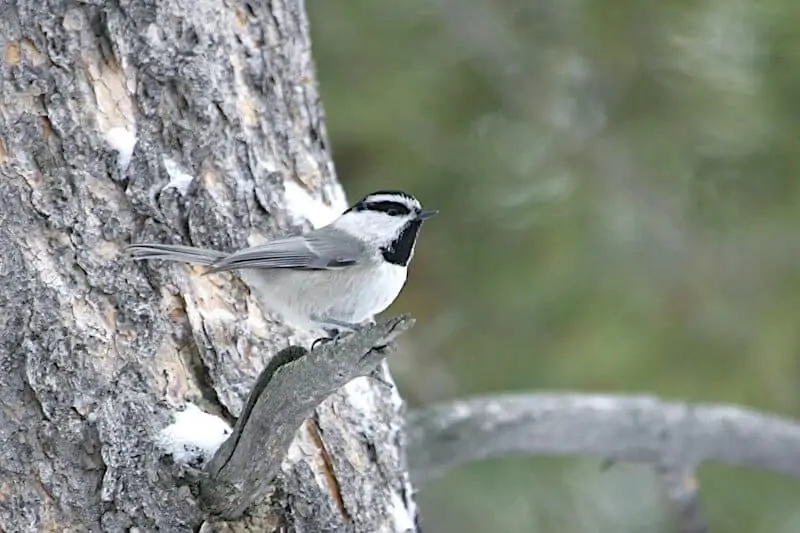
Scientific name: Poecile gambeli
Length: 4.3-5.5 in
Weight: 0.4 oz
Chickadees are tiny little birds with rounded bodies that are very easy to recognize because of their “black cap” and black throat. Their cheeks are solid white, their wings and backs are gray, and their underbodies are fluffy and light. In Utah you can also see black-capped chickadees, who we mentioned earlier on this list, but it is easy to tell them apart because only the mountain chickadee has the eye stripe above the eye. Their preferred habitat is evergreen forests in mountainous areas.
In Utah, mountain chickadees may be found all year.
Chickadees will typically feed seed to most seed feeders, mixing in black sunflower seeds. In the winter, they’ll often eat suet.
24. RED-BREASTED NUTHATCH

Scientific name: Sitta canadensis
Length: 4.3 in
Weight: 0.3-0.5 oz
Wingspan: 7.1-7.9 in
The back of these little nuthatches is dark gray, the chest and belly are rusty (ranging from vividly colored to light), and the face is boldly black and white striped. These small, agile birds are most often seen leaping about on tree trunks and branches, seeking for insects beneath the bark. They’ll utilize outdoor nest boxes as well as tree cavities for nesting.
Throughout the year, red-breasted nuthatches may be found in Utah, although their population often migrates during winters when conifer seeds are scarce.
Feeders are common for Red-breasted Nuthatches. Sunflower seeds, peanuts, and suet are all available.
HOW TO ATTRACT BIRDS TO YOUR YARD
Would you like to attract some of these birds to your garden? Starting with the most obvious, take a look at these 5 simple tips.
1. PUT OUT BIRD FEEDERS
A bird feeder or two is the simplest and most noticeable technique to attract birds to your yard. A basic tube feeder, hopper feeder, platform feeder, or window feeder are some of the suggestions I have for you. For each, there are several options listed below.
2. ADD A WATER SOURCE
You may utilize a terra cotta flower pot saucer, such as the one shown on Amazon, or something as basic as a pedestal birdbath like this one. Birds need water not just for bathing but also for drinking, and adding a pond to your property will only increase your chances of attracting birds. Additionally, since moving water attracts the birds to visit the water even more, consider adding a solar fountain.
3. OFFER BIRDHOUSES
If put in the appropriate area at the proper time of year, many bird species will readily take up residence in birdhouses. Among the most common birds sought after for birdhouses are Eastern Bluebirds. A mating pair of bluebirds was inspecting this birdhouse in my yard the same day I put it up.
4. PROVIDE SHELTER
Make sure there are trees, shrubs, and bushes in your yard that the birds can retreat to when they sense danger. Predators are the predators’ primary threat. Do your best to add some landscaping elements that will allow birds to view your yard as safe if your yard is in a new subdivision with no mature trees.
5. ADD NATIVE PLANTS
Having native plants that produce nuts, berries, and seeds will only help your efforts to attract more birds for many birds that eat them. Moreover, since most songbirds feed insects to their hatchlings, native plants protect caterpillars and other insects that feed many birds and support nesting birds. Invasive and non-native plants may compete with native vegetation, crowding out the natural flora that supports a healthy ecosystem.
10 DIFFERENT TYPES OF BIRD FEEDERS
Here are 10 of the most common bird feeders people set up in their yards.
- Hopper feeders are named after the hopper, which is a compartment in the middle that holds bird seed. Birds may land on and eat from the perches that ring the edges. To keep the seed dry, many hopper feeders are shaped like a house and covered on top. For this kind of feeder, use black sunflower seeds or a combination of birdseed. This is a squirrel-proof hopper feeder, which I adore.
- Platform feeders are open on top and may be hung from a tree or hook, or pole-mounted. They are sometimes known as tray feeders. They’re simple to put up and ideal for feeding most types of birds. Every beast in your yard that may reach them will eat from them, despite the fact that they are fully exposed. For this kind of feeder, use black sunflower seeds or a combination of birdseed. In my back yard right now, I’m using this platform feeder.
- Tube feeders are simple clear plastic tube-shaped bird feeders that are used to feed birds. They may vary in size from a few cups to 5 pounds or more, holding either seed or soil. They’re helpful because they preserve your seed while also allowing you to refill it when necessary. Tube feeders are used by a variety of birds. In tube feeders, you can use both black sunflower seeds and other seeds. This squirrel proof tube feeder is one of the best on the market, and Squirrel Buster makes some of the best.
- Suet feeders are used to feed one kind of bird food, suet cakes. They are a very basic idea, generally consisting of just a metal wire cage with a tail-prop for bigger birds. During the winter, when birds are seeking for high-fat foods, suet feeders are very popular with woodpeckers. To attract larger woodpeckers, like the Pileated and Northern Flicker, I recommend getting a suet feeder with a long tail prop.
- Window feeders are little bird feeders with suction cups that attaches to a glass window. They’re open on top and you pour the seed in from the tray area to fill them, similar to tray feeders. Several distinct sorts of birds enjoy these feeders, and they are simple to get started with. They are also ideal for homeowners who do not have vast yards. For this kind of feeder, use black sunflower seeds or a combination of birdseed. On Amazon, this is by far the most popular window feeder, and maybe the most popular bird feeder overall.
- Thistle feeders, often known as Nyjer feeders, are specialized bird feeders designed specifically for thistle seed. Birds in the finch family, which includes the American Goldfinch and House Finch, are among the most common types of birds attracted to thistle feeders. Thistle feeders are typically tubular in shape and have tiny holes along the tubular sides that allow birds to remove the thistle. Droll Yankees has a great thistle feeder.
- Ground feeders are tray feeders that sit on the ground surface. Birds such as Mourning Doves and Juncos, as well as squirrels, raccoons, and other ground animals, will all love them. For this type of feeder, use black sunflower seeds or a combination of birdseed. This recycled plastic ground feeder could be yours.
- Oriole feeders are a kind of specialty feeder that is used to feed one species of bird, orioles. Little plastic or glass jelly dishes are commonly used to feed the orioles, who prefer orange-colored food. Another food that orioles like is stuck orange halves onto the feeder, which they also allow. Here’s an inexpensive oriole feeder that holds four jelly trays and feeds orange halves.
- Hummingbird feeders, also known as hummingbird feeders, are made especially for hummingbirds to draw sugar water from. I frequently see Downy Woodpeckers at mine, even though they are meant for hummingbirds, and they also love that sweet nectar. Learn how to make hummingbird nectar without boiling the water by reading this article. There’s no need to spend a lot of money on a hummingbird feeder since they’re so simple and cost-effective.
- Peanut feeders are tube-shaped and typically made of metal wire mesh materials. They are similar to thistle feeders. To allow for whole unshelled or shelled peanuts to pass through the holes, only the holes in the wire mesh are much further apart. These feeders should be filled with peanuts, and they attract birds like Blue Jays. This Squirrel Buster squirrel feeder is the best way to keep squirrels out of your peanut feeder. The basic one will suffice in most cases.
BIRD WATCHING IN UTAH
If you want to extend your hobby outside of your own yard, Utah is a fantastic place to do so. If you want to get more engaged, the Utah Audubon Society has local chapters that host meetups, seminars, field excursions, and birding tours.
Take a look at this list of popular birding destinations in Utah if you’re a Utah resident and want to add some new species to your life list.
